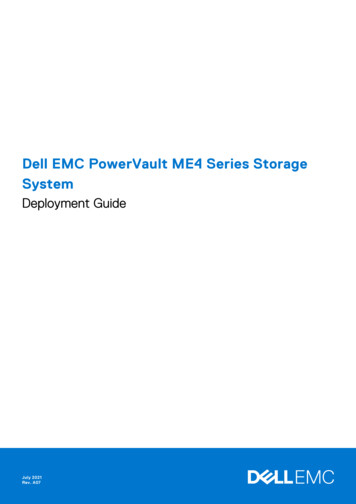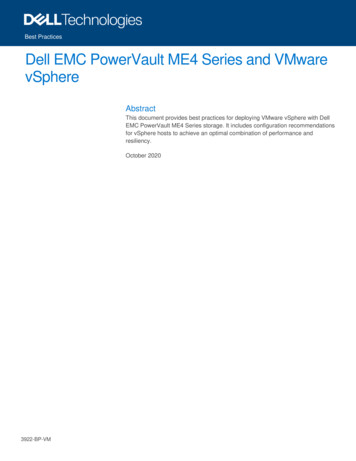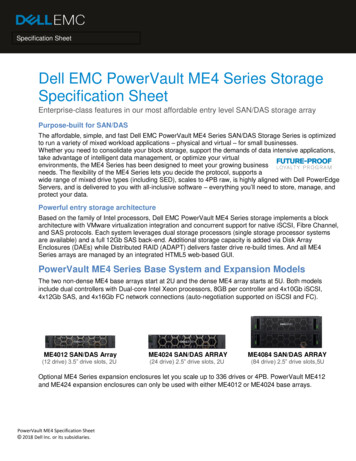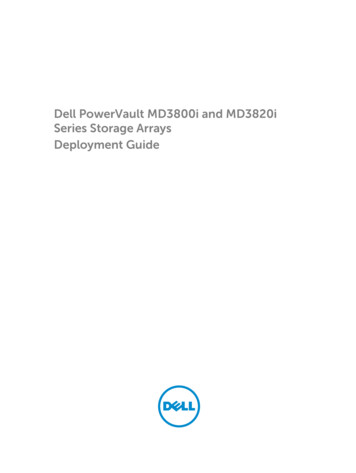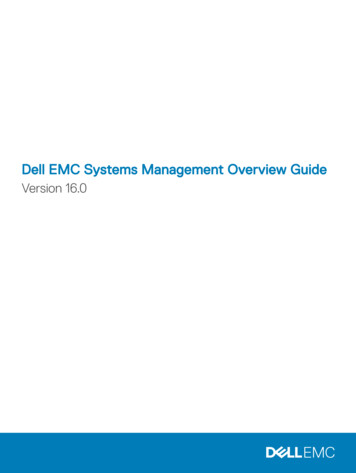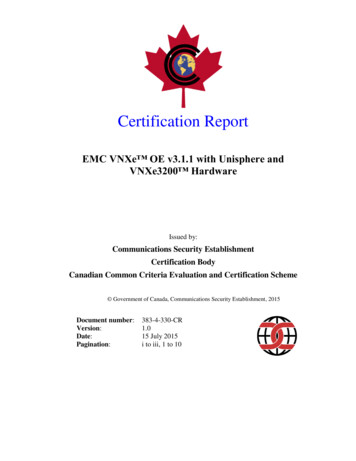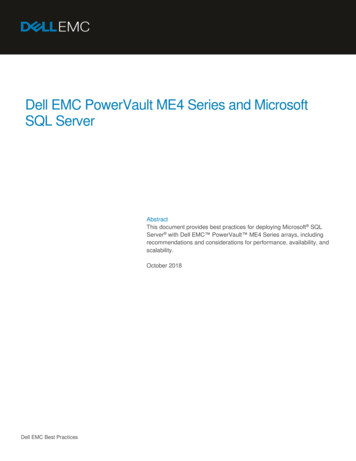
Transcription
Dell EMC PowerVault ME4 Series and MicrosoftSQL ServerAbstractThis document provides best practices for deploying Microsoft SQLServer with Dell EMC PowerVault ME4 Series arrays, includingrecommendations and considerations for performance, availability, andscalability.October 2018Dell EMC Best Practices
RevisionsRevisionsDateDescriptionSeptember 2018Initial releaseOctober 2018Added performance sectionAcknowledgementsAuthor: Doug BernhardtThe information in this publication is provided “as is.” Dell Inc. makes no representations or warranties of any kind with respect to the information in thispublication, and specifically disclaims implied warranties of merchantability or fitness for a particular purpose.Use, copying, and distribution of any software described in this publication requires an applicable software license. 2018 Dell Inc. or its subsidiaries. All Rights Reserved. Dell, EMC, Dell EMC and other trademarks are trademarks of Dell Inc. or its subsidiaries. Othertrademarks may be trademarks of their respective owners.Dell believes the information in this document is accurate as of its publication date. The information is subject to change without notice.2Dell EMC PowerVault ME4 Series and Microsoft SQL Server 3923-BP-SQL
Table of contentsTable of contentsRevisions.2Acknowledgements .2Table of contents .3Executive summary.4Audience .41Introduction .52Best practices overview .63SQL Server design considerations .74A3.1OLTP workloads .73.2OLAP/DSS workloads .73.3Mixed workloads .73.4ME4 Series configuration .73.5Validating the storage design .9Deploying SQL Server on ME4 Series storage .114.1Volume configuration .114.2SQL Server I/O reduction .12Technical support and resources .15A.13Related resources .15Dell EMC PowerVault ME4 Series and Microsoft SQL Server 3923-BP-SQL
Executive summaryExecutive summaryThis paper provides guidance for using Dell EMC PowerVault ME4 Series storage systems in aMicrosoft SQL Server environment. SQL Server is a robust product that can be used in a variety ofsolutions, allowing you to prioritize performance, manageability, and flexibility depending on yourenvironment. This paper provides important considerations and recommendations to help meet your designgoals, and builds upon the best practices in the ME4 Series Administrator’s Guide on Dell.com/support.This document was developed using the PowerVault ME4024 array, but is also applicable to ME4012 andME4084 arrays.Note: While following the best practices in this document is strongly recommended by Dell EMC, somerecommendations may not apply to all environments. For questions about the applicability of these guidelinesin your environment, contact your Dell EMC representative.AudienceThis document is intended for ME4 Series administrators, database administrators, architects, partners, andanyone responsible for configuring ME4 Series storage systems. Some familiarity with Dell EMC storagesystems is assumed.We welcome your feedback along with any recommendations for improving this document. Send commentsto StorageSolutionsFeedback@dell.com.4Dell EMC PowerVault ME4 Series and Microsoft SQL Server 3923-BP-SQL
Introduction1IntroductionThe PowerVault ME4 Series is next-generation, entry-level storage that is purpose-built and optimized forSAN and DAS virtualized workloads. Available in 2U or dense 5U base systems, the low-cost ME4 Seriessimplifies the challenges of server capacity expansion and small-scale SAN consolidation with up to 336drives or 4PB capacity. It also comes with all-inclusive software, incredible performance, and built-in simplicitywith a new web-based HTML5 management GUI, ME Storage Manager. Connecting ME4 Series storage to aPowerEdge server or to a SAN ensures that business applications will get high-speed and reliable access totheir data — without compromise.Product features include the following:Simplicity: ME4 Series storage includes a web-based management GUI (HTML5), installs in 15 minutes,configures in 15 minutes, and easily deploys in 2U or 5U systems.Performance: Compared to the predecessor MD3 Series, the ME4 Series packs a lot of power and scale withthe Intel Xeon processor D-1500 product family. The ME4 Series processing power delivers incredibleperformance gains over the MD3 Series, as well as increased capacity, bandwidth, and drive count.Connectivity: ME4 Series storage goes to the next level with robust and flexible connectivity starting with a12Gb SAS back-end interface, and a front-end interface options including four 16Gb FC ports per controller,four 10Gb iSCSI ports per controller (SFP or BaseT), or four 12Gb SAS ports per controller.Scalability: Both 2U and 5U base systems are available, with the 2U system supporting either 12 or 24 drivesand the 5U system supporting 84 drives. Each of the 2U (ME4012 and ME4024) and 5U (ME4084) basesystems supports optional expansion enclosures of 12, 24, and 84 drives, allowing you to use up to 336drives. Drive mixing is also allowed.All-inclusive software: ME4 Series software provides volume copy, snapshots, IP/FC replication, VMware VCenter Server and VMware Site Recovery Manager integration, SSD read cache, thin provisioning,three-level tiering, ADAPT (distributed RAID), and controller-based encryption (SEDs) with internal keymanagement.Management: An integrated HTML5 web-based management interface (ME Storage Manager) is included.For more information, see the ME4 Series product page.5Dell EMC PowerVault ME4 Series and Microsoft SQL Server 3923-BP-SQL
Best practices overview2Best practices overviewUse the following general steps to set up and configure an ME4 Series system for SQL Server:1. Capture the storage I/O performance characteristics and capacity requirements of your SQL Serverworkload.2. Review the remaining sections of this document and apply the best practices that are applicable toyour workload and environment. Since SQL Server workloads can vary, not all recommendations mayapply.3. Follow the deployment instructions for setting up an ME4 Series system found in the ME4 SeriesDeployment Guide on Dell.com/support.4. Configure the ME4 Series system using the ME4 Series Administrator’s Guide, applying bestpractices for Microsoft Windows and SQL Server as recommended by Dell EMC.6Dell EMC PowerVault ME4 Series and Microsoft SQL Server 3923-BP-SQL
SQL Server design considerations3SQL Server design considerationsThe I/O storage system is a critical component of any SQL Server environment. Sizing and configuring astorage system without understanding the I/O requirements can have disastrous consequences. Analyzingperformance in an existing environment using a tool like Live Optics can help define the I/O requirements.Your Dell EMC representative can assist with Live Optics data collection and analysis. For best results,capture performance statistics for a period of at least 24 hours that includes the system peak workload.3.1OLTP workloadsWhile every environment is unique, an online transaction processing (OLTP) workload typically consists ofsmall, random reads and writes. A storage system for OLTP workloads is primarily sized based on capacityand the number of IOPS required.3.2OLAP/DSS workloadsAn online analytic processing (OLAP) or decision support system (DSS) workload is typically dominated bylarge, sequential reads. A storage system for OLAP/DSS workloads is primarily sized based on throughput.When designing for throughput, the performance of the entire path between the server and the drives in theME4 Series array needs to be considered. For best throughput, consider using 16 Gb Fibre Channel (FC) or10 Gbps iSCSI connectivity to the array. To meet high-throughput requirements, multiple physical paths maybe required.3.3Mixed workloadsThe most common scenario for a SQL Server environment is a mixed workload. Typically, SQL Server I/Opatterns do not strictly fall into an OLTP or OLAP pattern. This is what can make SQL Server workloadschallenging because no two workloads behave the same. In addition, the same SQL Server host or instancemay be servicing multiple applications or transaction workloads.A mixed workload can also imply that multiple applications (in addition to SQL Server) are residing on thesame host or accessing the same storage. The combined workload of these applications invalidates anytypical application I/O usage pattern. For these reasons, it is important to gather actual performance metricsfor best sizing results.3.4ME4 Series configuration3.4.1Balanced configurationCreating a balanced storage configuration is important because SQL Server workloads can vary greatly andI/O patterns can often fluctuate due to changes in the database environment, evolving data-access patterns,or data growth. For most SQL Server workloads, it is recommended to configure the ME4 Series array usingthe virtual storage type and ADAPT as the RAID level.For best performance, a minimum of 24 drives should be used when using the ADAPT RAID level becausethis is the minimum number required to create two virtual storage pools, one per controller in a dual-controllersystem. Start with 24 SSD drives and add additional drives as needed to achieve performance and capacityrequirements. An ME4 Series array with SSDs spread evenly across 2 virtual storage pools (one percontroller) configured with the ADAPT RAID level provides the best overall balance of performance, flexibility,capacity, and data protection.7Dell EMC PowerVault ME4 Series and Microsoft SQL Server 3923-BP-SQL
SQL Server design considerationsThere is a variety of other RAID levels and storage configurations available for very specific workloads. Makesure the design tradeoffs are completely understood when choosing custom configurations and settings. Inmany cases, modifying the storage configuration for existing volumes will involve halting I/O on thosevolumes, resulting in a SQL Server outage. For detailed information on all available choices, includingADAPT, consult the ME4 Series Administrator’s Guide.3.4.2RAID levels and performanceThe performance characteristics of the ME4 Series are largely dependent on the RAID level chosen for thestorage configuration. While the ADAPT RAID level provides the most balanced configuration, other RAIDlevels are available for maximum performance or maximum capacity. The two additional levels discussed inthis section are RAID 5 and RAID 10. For all available RAID levels, consult the ME4 Series Administrator’sGuide. The performance numbers presented are maximum values on an ME4 Series array with a minimum of24 drives and two storage pools, one per controller.Note that performance among RAID levels only has significant variation in workloads such as OLTP wherefrequent writes occur. For read-only workloads such as OLAP, there is practically no performance benefit toselect RAID levels based on performance.Use care when configuring multiple RAID levels on the same ME4 Series array. Ensure that the number ofdrives in the storage pool is sufficient to provide the performance desired. Mixing RAID levels within a storagepool is not recommended.Remember that when selecting RAID levels, there are design considerations other than performance. RAIDlevels impact the data protection, capacity, and flexibility of the overall storage design. Therefore, finding thebest balance of performance, data protection, capacity, and flexibility is the goal.3.4.2.1ADAPTWhen using the ADAPT RAID level, the ME4 Series can perform up to 99,000 IOPS using an OLTPworkload1 and up to 7 GB/sec for OLAP workloads2. The solid OLTP performance and outstanding readperformance, as well as the balance of performance, capacity, and data protection, make ADAPT a goodchoice for mixed-database workloads.3.4.2.2RAID 5When additional performance and capacity is required, RAID 5 may be used. In a RAID 5 configuration, somedisk resources that were reserved for data protection are utilized for additional capacity and performance.Therefore, RAID 5 offers less data protection than ADAPT. However, it can deliver up to 115,000 IOPS forOLTP workloads1.3.4.2.3RAID 10For maximum OLTP performance, RAID 10 can deliver up to 192,000 IOPS for OLTP workloads1. In a RAID10 configuration, the usable capacity is reduced to 50% of raw capacity. Therefore, a RAID 10 solutionrequires almost double the number of drives compared to more space-efficient RAID types.128An OLTP workload is defined as having an 8k block size and a 70/30 read/write mix.An OLAP workload is defined as having a 128k block size with 100% reads.Dell EMC PowerVault ME4 Series and Microsoft SQL Server 3923-BP-SQL
SQL Server design considerationsFigure 1 compares the OLTP performance for each RAID type.Max OLTP IOPS by RAID 00050,0000ADAPTRAID 5RAID 10Maximum OLTP IOPS by RAID level33.5Validating the storage designOnce the I/O requirements have been defined, it is easy to determine whether the hardware can provide thedesired performance by running some simple tests. Diskspd is a free Microsoft utility that can simulate I/Opatterns generated by SQL Server. There are several other utilities available as well. When selecting a utilityto simulate I/O, verify that it meets the following requirements: 3.5.1Ability to configure block sizeAbility to specify number of outstanding requestsAbility to configure test file sizeAbility to configure number of threadsSupport for multiple test filesDoes not write blocks of zeros during testsValidating the I/O pathThe first thing to test on a new configuration is the path between the server and the array. Running a largeblock sequential read test using small files should saturate the path between the server and the array. Thistest verifies that all paths are fully functional and can be used for I/O traffic. Run this test on a dedicatedserver and array; a live system could cause significant performance issues.39An OLTP workload is defined as having an 8k block size and a 70/30 read/write mix.Dell EMC PowerVault ME4 Series and Microsoft SQL Server 3923-BP-SQL
SQL Server design considerationsTo validate the I/O path, run a large block sequential read test using the following guidelines: Create one LUN per storage processor.Format the volumes using a 64 KB allocation unit.Use a block size of 512 KB for the test.Configure the test for 32 outstanding I/Os.Use multiple threads. Eight is the recommended starting point.If the displayed throughput matches the expected throughput for the number of HBA ports in the server, thepaths between the server and ME4 Series array are set up correctly.3.5.2Validating the drivesOnce the I/O path has been validated, the next step is to test the drives. For best results when testing driveson an ME4 Series array, use the following guidelines when configuring the test: In a dual-controller system, use at least one volume per pool with each pool on a separate controller.This ensures that I/O will be distributed across both controllers. Using both controllers provides amore accurate simulation of real-world activity. For best results, use the same number of volumes oneach controller.When performing I/O tests on any storage platform, it is important to use files that are larger than thecontroller cache. For more accurate results, use a file size that matches the amount of data beingstored. In an environment where that is not practical due to a large data set, use a file size of at least100 GB.Avoid using test utilities to generate files full of zeros for drive validation. Some I/O test tools,including Diskspd, SQLIO and IOMeter, can be used to write zeroes for drive validation, which causesinaccurate results when testing with files containing only zeros. The contents of the test file can beverified by viewing the test file with a hex editor after different stages of a test. For example, create asmall test file and view it after the initial creation, as well as after the test has run for a few seconds. Ifthe file is filled with zeros, select another utility. Diskspd and IOMeter initially create test files filledwith zeros, and then write random characters when performing write tests. To properly initialize aDiskspd or IOMeter test file, run a sequential write test until the entire file has been overwritten withnon-zero data. Unfortunately, SQLIO writes zeros during write tests and therefore is notrecommended for drive validation.The purpose of this drive testing is to validate that the storage design will provide the required throughput andIOPS with acceptable latency. It is important that the test does not exceed the designed capacity of the array.For example, an array designed for a workload of 5,000 IOPS is likely to perform poorly with a workload of10,000 IOPS. If a test is generating a workload higher than the designed capacity, adjust the workload beinggenerated by reducing the number of threads or outstanding I/Os.The results of the Live Optics analysis provide an I/O target to simulate using these tests. To estimate theperformance capabilities of the array, run I/O tests with a range of I/O sizes commonly seen with SQL Server.When testing random I/O, test with an I/O size of 8 KB and 64 KB. When testing sequential I/O, start with I/Osizes of 8 KB and 64 KB. Since processes like read-ahead scans and backups can issue much largersequential I/O, it is a good idea to also test block sizes up to 1024 KB.10Dell EMC PowerVault ME4 Series and Microsoft SQL Server 3923-BP-SQL
Deploying SQL Server on ME4 Series storage4Deploying SQL Server on ME4 Series storageProper architecture and configuration of the SQL Server environment is critical to optimize performance andmanageability of the ME4 Series array and SQL Server environment. Apply the following best practices whendesigning, configuring, and managing SQL Server databases on ME4 Series storage.4.1Volume configuration4.1.1Creating volumesThere are many types of files that are part of a SQL Server instance. Those types of data often have differentperformance requirements. For performance-sensitive applications, Dell EMC recommends creating at leastfive volumes for an instance of SQL Server as shown in Table 1.Volume-provisioning recommendations4.1.2File typeNumber of volumesTypical performance requirementsUser DB dataAt least 1 per instanceLower performance may be acceptableUser DB transaction logAt least 1 per instanceHigh performance requiredData root directory(includes system DBs)1 per instanceLower performance may be acceptableTempdb data and transaction log1 per instanceHigh performance may be requiredNative SQL Server backup1 per instanceLower performance may be acceptableMemory-Optimized Filegroup (if used)At least 1 per instanceHigh performance requiredPerformance considerationsWhen there is one group of databases that require high performance and another group that does not,consider creating a set of volumes for each group of databases. This strategy will make it easier to adjust thestorage configuration in the future. It also makes it easier to distribute the I/O load evenly across bothcontrollers. Databases that have very high performance requirements can be spread across two or more datafiles on separate volumes to leverage resources on both controllers.4.1.3Flexibility and manageabilityFor ultimate flexibility, create a volume for each user database file. This provides the ability to independentlyoptimize the storage for each individual database. With thin provisioning, there is no space penalty forcreating numerous volumes. However, a large number of volumes can be difficult to manage, especially invirtualized environments. It is up to the DBA or storage administrator to find the right balance betweenflexibility and manageability when determining the number of volumes to create. Virtualized SQL Serverenvironments are a good example where placing multiple file types on a single volume can make sense.Understanding the database I/O patterns is critical to making the best decisions.4.1.4Windows setup and configuration4.1.4.1Allocation unit sizeUse a 64 KB allocation unit size when formatting volumes that will contain database files (transaction log anddata) or database backups.11Dell EMC PowerVault ME4 Series and Microsoft SQL Server 3923-BP-SQL
Deploying SQL Server on ME4 Series storage4.1.4.2MPIOME4 Series arrays support Asymmetric Logical Unit Access (ALUA), and when MPIO is configured, thedefault MPIO policy is round robin with subset. This is the recommended setting for all database volumes.This setting works best for most environments because it is easy to manage and performs very well. Useother MPIO policies with caution and remember to review custom MPIO policies when adding or removingvolumes from the host.4.2SQL Server I/O reduction4.2.1MemoryUnnecessary I/O can be avoided and performance can be increased by allocating the proper amount ofmemory to SQL Server. SQL Server performs all I/O through the buffer pool (cache) and therefore uses alarge portion of its memory allocation for the buffer pool. Ideally, when SQL Server performs I/O, the data isalready in the buffer pool and it does not need to go to disk. This type of I/O is referred to as logical I/O and isthe most desirable because it results in the best performance. If the SQL Server data does not need to residein the buffer pool, it will need to access disks, resulting in physical I/O.Proper memory allocation is critical to SQL Server performance and can improve storage performance aswell. In many cases, SQL Server and storage performance can be further improved by adding memory.Adding memory generally improves performance, but there is a point of diminishing returns that is unique toeach environment.4.2.2Buffer pool extensionWith SQL Server 2014, the buffer pool can be extended to a file on the file system to provide additional spaceto cache data or index pages. Using this feature can provide significant performance benefits without addingmemory to the database server in some cases. By caching more pages on the server, the I/O load on thearray is reduced.When placing the buffer pool extension on the array, create a separate volume for the buffer pool extensionand do not take snapshots of the buffer pool extension volume. The buffer pool data is repopulated by SQLServer when the instance is restarted, therefore data recovery does not apply.4.2.3Database compressionThe overall I/O workload can be reduced by enabling database compression in SQL Server. While there is atradeoff in terms of CPU utilization on the database server, compression is still a viable option to consider andtest in any environment. Database compression reduces I/O by reducing the amount of data that needs to bestored. The SQL Server data pages are compressed in memory before being written to disk, resulting in fewerpages needed to store the same number of rows and therefore less I/O.4.2.4Instant file initializationBy default, SQL Server writes zeros to the data file during the allocation process. The process of zeroing outthe data files consumes I/O and acquires locks as the SQL Server data pages are written. This activity canoccur for minutes or even hours depending on the file size. While this may seem minor, writing zeros to thesefiles can occur at critical periods when time and performance are critical such as database auto growth,expanding a full data file, replication, or restoring a database as part of a disaster-recovery event.12Dell EMC PowerVault ME4 Series and Microsoft SQL Server 3923-BP-SQL
Deploying SQL Server on ME4 Series storageWhen Instant File Initialization is enabled, SQL Server will skip the process of zeroing out its data files whenallocating space. Dell EMC recommends enabling Instant File Initialization.4.2.5Resource GovernorThe Resource Governor was added in SQL Server 2008 to allow database administrators to limit the CPUand memory resources that a query is able to consume. This feature was enhanced in SQL Server 2014 toallow I/O resources to be limited as well. For example, the Resource Governor can be used to reduce theimpact of a user running an I/O-intensive report by limiting the maximum number of IOPS that user canperform. While a query throttled by the Resource Governor will take more time to complete, overall databaseperformance will be better.4.2.6Database design considerationsReducing SQL Server I/O requires a holistic approach. Many of the items in this section will requireinvolvement from the whole team responsible for the SQL Server applications including the business owner,architect, developer, database administrator, and system administrator. Decisions at the design level have amultiplied impact downstream because data is written and read multiple times and duplicated in various typesof database copies including databases copied for other uses such as testing and reporting, replicateddatabases, replicated storage, and backups.One of the most challenging aspects of SQL Server is that the I/O pattern and the amount of I/O that isgenerated can vary greatly depending on the application, even if those applications have databases of thesame size. This is because the design of both the database and the data-access code control theSQL Server I/O.Database tuning can be one of the most cost-effective ways to reduce I/O and improve scalability. At a highlevel, consider the tips in the following subsections when tuning a database to reduce I/O.4.2.6.1Database designThe foundation of the entire database and the schema for how data will be stored and ultimately accessed isdetermined by the database design. The database design should support both usability and efficient dataaccess. This includes efficient table design and data types as well as indexes, partitioning, and other featuresthat can improve efficiency. It is common for database design to only be focused on usability whileperformance and scale are overlooked.4.2.6.2Query designHow a query is written can greatly affect the amount of I/O SQL Server needs to perform when executing thequery. Queries should return only the required amount of data in the most efficient manner possible. Tune thequeries responsible for consuming the most resources for best performance and scale.4.2.6.3Application designConsider how applications are using the data and how the data is requested. Sometimes code andcomponent reuse can result in the same data being unnecessarily retrieved repeatedly. All data accessshould be purposeful.4.2.6.4MaintenanceSQL Server uses a cost-based optimizer to generate query plans for data access. These plans are based onthe statistics regarding how data is distributed in the tables. If the statistics are inaccurate, bad query plansmay result and unnecessary I/O will be performed. Proper database maintenance includes ensuring thatstatistics are up to date.13Dell EMC PowerVault ME4 Series and Microsoft SQL Server 3923-BP-SQL
Deploying SQL Server on ME4 Series storageFrequent data modifications can also lead to fragmentation within SQL Server data files, producingunnecessary I/O. Fragmentation can be addressed through index reorganization or rebuilds as part of regulardatabase maintenance.The database maintenance process itself can also have a large I/O impact. Typically, every table and indexdoes not need to be rebuilt or reorganized every time maintenance is run. In addition,
with a new web-based HTML5 management GUI, ME Storage Manager. Connecting ME4 Series storage to a PowerEdge server or to a SAN ensures that business applications will get high-speed and reliable access to their data — without compromise. Product features include the following:
